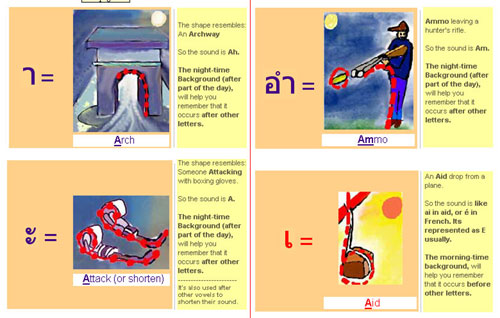Learning Thai Vowels
Thai vowels are considerably different to their english couterparts,
at first glance. In many ways though, they are actually easier
and more consistent. While english has five official vowels, Thai
actually has a total of 32 different vowel configurations. Don't
be shocked at this though - on closer inspection the differences
begin to dissolve.
While english has 5 official vowels, there are far more vowel
sounds. Many of these extra vowel sounds arise from the combination
of individual vowels into little gangs, that will change the vowel
sound. These little groups of vowels are known as diphthongs (for
those linguistically inclined). An example is the combination "ai",
as in "air", or "aisle". When you start adding
up all the different sounds that can be created by combinations
of individual vowels in english, you end up with a lot of vowel
sounds.
This is essentially why there are apparently more vowel in thai
- because each vowel represents a vowel sound. Hence diphthongs
don't appear in Thai the way they do in english, as the diphthongs
essentially come pre-packaged in the symbol for the vowel. One example
of this is thai, is the symbol that represents the "ai"
sound in "aisle". This is represented by one symbol, not
a combination of two different symbols "a" and "i".
The reason that Thai vowels are easier than english vowels, in
certain respects, is because they are consistent. The symbol
that represents the "ai" in "aisle", always
sounds like "ai" in "aisle". Whereas in english
the combination "ai" can have entirely different pronunciations
depending on the word that you find it in: "air" vs. "aisle".
The other thing that takes the sting out of learning "32"
different vowels, is that there are only slight variations between
some vowels and others. These variations are caused by adding an
additional symbol after the vowel which just makes the sound shorter.
It doesn't change the essential characteristics of the sound, just
the length of it: like a "long a" vs. a "short a".
The net impact of the above is that you'll only really have to
learn around 20 individual vowel shapes, and their corresponding
sounds. The rest can be logically derived from these.
Sample page from the book:

|


